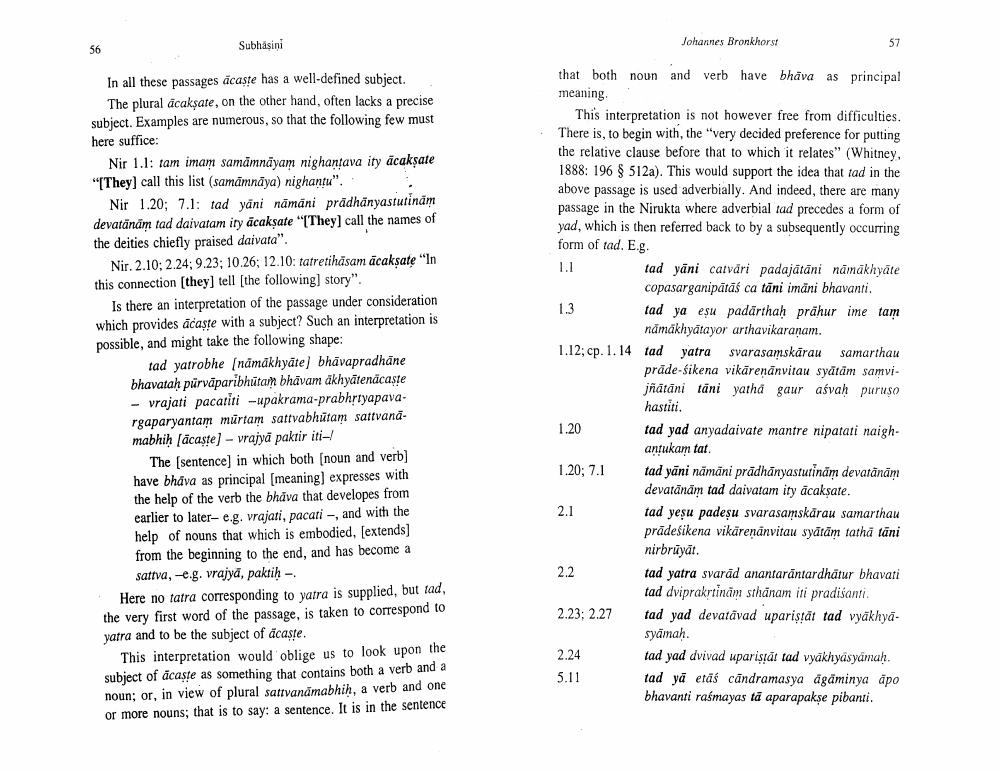Book Title: Yaska And Sentence Beginning Ofsabdabodha Author(s): Johannes Bronkhorst Publisher: Johannes Bronkhorst View full book textPage 7
________________ Subhasini Johannes Bronkhorst 57 1.3 In all these passages acaste has a well-defined subject. The plural acakşate, on the other hand, often lacks a precise subject. Examples are numerous, so that the following few must here suffice: Nir 1.1: tam imam samāmnāyam nighantava ity acakşate "[They) call this list (samāmnāya) nighantu". Nir 1.20; 7.1: tad yani nāmäni prādhänyastutinām devatänām tad daivatam ity acaksate "[They call the names of the deities chiefly praised daivata". Nir. 2.10:2.24; 9.23; 10.26; 12.10: tatretihāsam ācaksate "In this connection they tell [the following) story". Is there an interpretation of the passage under consideration which provides acaste with a subject? Such an interpretation is possible, and might take the following shape: tad yatrobhe (nāmākhyāte) bhāvapradhane bhavatah purvāparibhūtam bhāvam akhyātenacaste - vrajati pacatiti-upakrama-prabhrtyapavargaparyantam murtam sattvabhūtam sattvanamabhih (ācaste) - vrajyā paktir iti-/ The [sentence] in which both (noun and verb] have bhava as principal (meaning) expresses with the help of the verb the bhāva that developes from earlier to later- e.g. vrajati, pacati -, and with the help of nouns that which is embodied, [extends) from the beginning to the end, and has become a sattva, -e.g. vrajya, paktih - Here no tatra corresponding to yatra is supplied, but tad, the very first word of the passage, is taken to correspond to yatra and to be the subject of acaste. This interpretation would oblige us to look upon the subject of acaste as something that contains both a verb and a noun; or, in view of plural sattvanāmabhih, a verb and one or more nouns; that is to say: a sentence. It is in the sentence that both noun and verb have bhāva as principal meaning. This interpretation is not however free from difficulties. There is, to begin with, the "very decided preference for putting the relative clause before that to which it relates" (Whitney, 1888: 196 $ 512a). This would support the idea that tad in the above passage is used adverbially. And indeed, there are many passage in the Nirukta where adverbial tad precedes a form of yad, which is then referred back to by a subsequently occurring form of tad. E.g. tad yāni carvári padajātāni nāmākhyāte copasarganipātāś ca tāni imani bhavanti. tad ya esu padārthah prähur ime tam nămakhyatayor arthavikaranam. 1.12; cp. 1.14 tad yatra svarasamskärau samarthau prāde-śikena vikāreņānvitau syātām samvi. jñātāni tani yatha gaur aśvah puruso hastiti. 1.20 tad yad anyadaivate mantre nipatati naigh antukam tat. 1.20; 7.1 tad yani nämäni prādhānyasturinam devatänän devatänän tad daivatam ity acakşate. tad yesu padeșu svarasamskärau samarthau prādesikena vikārenanvitau syātām tathā tāni nirbruyar. tad yatra svarād anantaräntardhätur bhavati tad dviprakrtinam sthanam iti pradišanti. 2.23: 2.27 tad yad devatavad uparistāt tad vyakhya syāmah. 2.24 tad yad dvivad uparistāt tad vyakhyasyamah. 5.11 tad ya etās cândramasya ägäminya apo bhavanti rasmayas tā aparapakşe pibanti.Page Navigation
1 ... 5 6 7 8 9 10
